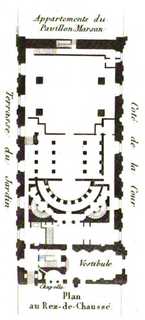Salle des Machines
Louis Le Vau
alias Théâtre des Tuileriespalais des Tuileries | |
| show on the map | http://fr.wikipedia.org/wiki/Salle_des_Machines |
Important events
People
History
"The form of the house was an oblong square, terminating in a semicircle. From the front of the stage it was ninety-three feet in length by fifty-two in breadth, and forty-two in height. Three rows of steps surrounding the pit, which alone was capable of containing fourteen hundred spectators standing, and an amphitheatre with seats affording more than twelve hundred places, served as a basement for two ranges of Corinthian columns and galleries ; a third range rested upon the entablature of the second. Behind these ranges were amphitheatres, each containing more than seven hundred places. The bases and capitals of the columns, as well as the cornices and balustrades, were richly gilt. The ceiling, magnificently sculptured and gilt after the designs of Lebrun, was adorned with paintings by Noel Coypel.
The proscenium was unencumbered with boxes, and presented grand columns of the composite order, sup-porting an elliptical arch surmounted by an attic and a pediment. The stage was one hundred and thirty-seven feet in depth by sixty-four in breadth.
....
The theatre is approached by a vestibule which communicates with the chapel, and by a grand staircase leading to the upper storeys. On a level with the first tier of boxes is a saloon decorated with columns of the Ionic order, which communicates at its extremities with the box lobbies, and by three intercolumniations in the centre with the stairs of the galleries and the royal box. The house forms a square with a circular part attached to one of its sides. A basement which extends round the house supports a colonnade of the Ionic order.
In front of the colonnade is a tier of boxes destined for the most distinguished spectators. At the bottom the colonnade is detached, and the royal box occupies three intercolumniations. The pit is formed of the square part in the centre. In the basement are the baignoire. The back wall of the circular colonnade is adorned with bas-reliefs. Between the columns on the sides is a second tier of boxes decorated with rich green draperies fastened with gold. Above the entablature under the arches is a third tier of boxes. An elliptical dome rests upon the four arches. The archivault of the proscenium is supported by four projecting columns, between which are boxes decorated with draperies.
All the architecture is painted to represent violet breccia, with mouldings richly gilt. The draperies are light green. The dome, the friezes, and the arches are sumptuously decorated with figures and other ornaments. The curtain is a drapery in ample folds and richly ornamented."
In: Whittaker, G. B.: The History of Paris from the Earliest Period to the Present Day: Vol. II. London, 1825 p. 501 - 504
Author: G. B Whittaker
G. B Whittaker:
Comédie-Française, Salle Richelieu, Théâtre de Variétés, Conservatoire National Supérieur d'Art Dramatique, Théâtre du Gymnase - Marie Bell, Theatre of the Comic-Ambiguity, Théâtre de la Porte Saint-Martin, Théâtre national de l'Opéra-Comique, Petit Bourbon, Odéon - Théâtre de l'Europe, Théâtre Feydeau, Cirque-Olympique in Mont Thabor Street, Salle des Machines, Theatre of Young Artists, Second Théâtre du Marais, Théâtre de la Gaîté, Théâtre National de la rue de la Loi, Salle Le Peletier, Panorama-Dramatique, Théâtre Louvois, Le Cirque-Olympique, Théâtre de la Société Olympique, Théâtre de la MolièreAdditional information
No information has yet been entered
Add information













